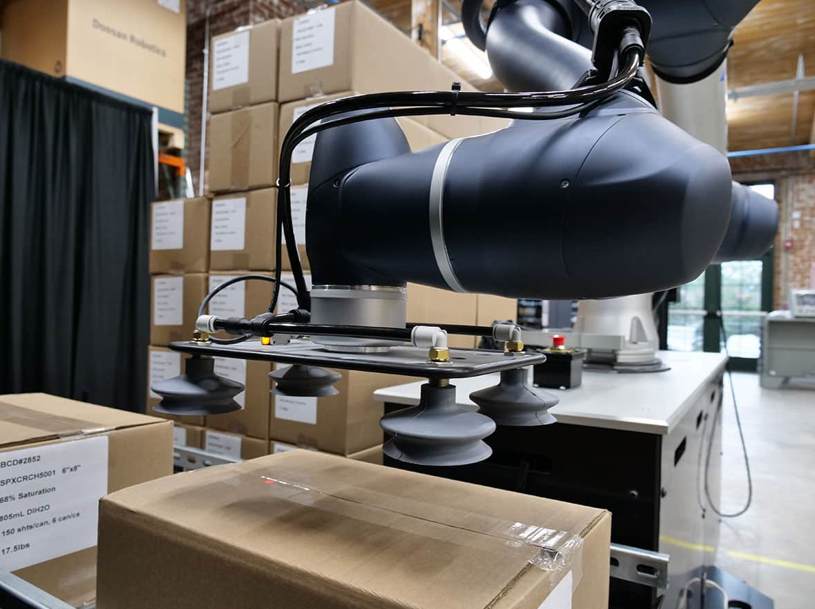UMass Amherst Research Advances Collaboration in Multi-Robot Systems
Researchers find that a learning model where robots must wait patiently and collaborate on appropriate tasks leads to more efficient operations and outcomes.
University of Massachusetts Amherst researchers have published leading research on a new approach for coordinating multi-robot teams in manufacturing environments. The researchers called their method learning for voluntary waiting and subteaming (LVWS). The research is intended to pave the way for new approaches to tackling diverse tasks in industrial environments with a team of robots that can wait for bot team members to help with tasks to maximize efficiency and join with suitable team members to get tasks done.

Researchers pioneer a model integrating robot waiting and subteaming to execute a diverse range of tasks. Image used courtesy of Cross Company
Establishing an Effective Coordination Mechanism
In a warehouse environment, the roles required to take care of incoming goods include a warehouse stocker, packer, general laborer, supervisor, material handlers, loaders, forklift driver, and inventory manager. Human workers in these roles collaborate to work with maximum speed and efficiency to process and store goods. To work together efficiently, human workers must leverage good communication and coordination to ensure everyone works toward a desired goal.
Can robotic systems work in a corroborated fashion like the workers within a warehouse environment? Well, we know they can. Sorting and packing machines function in a fixed position with autonomous mobile robots tactfully weaving in and out of tight warehouse spaces and past human workers to deliver goods to them. Mobile bots have built-in sensors, mapping technologies like SLAM, and object avoidance strategies to help people navigate their environment, including other bots. This level of navigational skill is impressive but does not necessarily involve finely honed, intuitive coordination.
Humans can understand and assess environmental situations and colleagues' capabilities to work dynamically, changing task allocation when necessary to achieve an overall goal. Can this be achieved by having teams of multiple robots working together? This is what Associate Professor at UMass Amherst Manning College, Hao Zhang, and his research colleagues believe is possible.
Assessment of Model Performance
The researchers devised a computer simulation wherein six robots were given a total of 18 tasks to complete as a team. The LVWS approach was run alongside four other computer models to assess its performance. The computer model integrated a solution that was considered the most optimal for completing the tasks in the most efficient way possible. They aimed to determine the degree to which each approach approximated the optimal solution.
The simulated multi-robot system in action. Video used courtesy of Human-Centered Robotics Lab @ UMass Amherst
The other approaches performed between 12% and 23% poorer than the ideal approach. The new LVWS approach was only suboptimal by 0.8%, performing better than the other computer models.
The team also modeled a scenario where a multi-robot team had to complete 100 tasks, where an optimum solution was not easy to come by. The researcher found that the LVWS approach finished all tasks in 22 timesteps compared to 23.05 to 25.85 timesteps for the other models.
Patience is the Key to Success
The researchers believe patience is the key to operational success with a multi-robot team. Suppose three robots were undertaking tasks independently (two with a capacity to lift 4 pounds and one larger robot with a capacity to lift 10 pounds), and an event occurred where a 7-pound box needed to be moved while one of the 4-pound-bearing robots was occupied. What would be the ideal solution?
The team asserts that it would be more beneficial for one of the smaller robots to wait for the other small robot to lift and move the box together. The larger robot would then be freed up to help take on other heavy-weight-bearing tasks.
Professor Zhang and his colleagues intend to further their research to enable robots to work in a collaborative, coordinated manner within industrial spaces, improving workflows and overall productivity.
This study was nominated as a finalist for the IEEE International Conference on Robotics and Automation 2024's Best Paper Award on Multi-Robot Systems.

 Facebook
Facebook Google
Google GitHub
GitHub Linkedin
Linkedin








